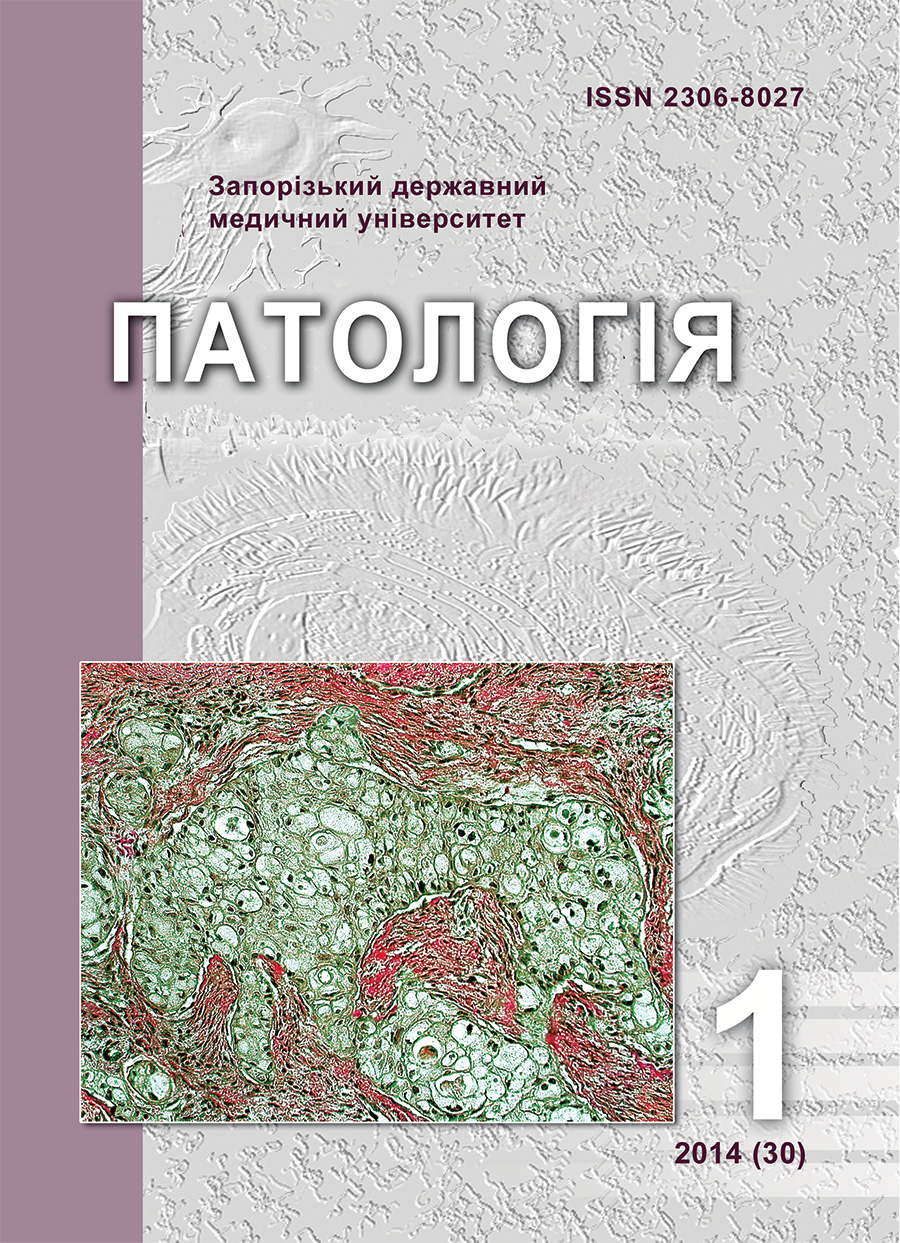HORMONAL DISORDERS AND COMPONENTS OF METABOLIC SYNDROME IN PATIENTS AFTER MYOCARDIAL INFARCTION
DOI:
https://doi.org/10.14739/2310-1237.2014.1.25156Keywords:
myocardial infarction, metabolic syndrome, insulin, C-peptide, leptin, Hydrocortisone, Thyreotropin, ThyroxineAbstract
Introduction. Hormonal disorders can be considered as one of the pathogenic factors of myocardial infarction in patients with metabolic syndrome. The level of insulin, leptin, C-peptide, cortisol, thyroid status metabolism in patients with myocardial infarction and metabolic syndrome in accordance to its components have been studied insufficiently.
Objective: to explore the features of hormonal disorders and their statistico-correlational interrelations with the components of metabolic syndrome in patients after acute myocardial infarction.
Materials and methods. The study involved 153 patients with Q-myocardial infarction in age from 40 to 85 years (mean age 62,5±0,90 years) in the acute stage of the disease: 122 - with metabolic syndrome and 31 - without metabolic syndrome. The control group consisted of 22 healthy individuals with normal carbohydrate metabolism, compared by age and sex. Depending on the components of metabolic syndrome patients of the basic group were divided in following manners: Group 1 - 36 patients with type 2 diabetes, obesity, hypertension and dislipoproteinemia (full metabolic syndrome), group 2 - 34 patients with obesity, hypertension, dislipoproteinemia and normal indicators of fasting glucose (in the absence of diabetes); Group 3 - 52 patients with type 2 diabetes, hypertension, and dislipoproteinemia and normal body weight (without obesity).
Results. Statistically significant increasing of leptin, insulin, cortisol, C-peptide, TSH levels and decreasing of free T4 level in patients with Q-myocardial infarction with metabolic syndrome were revealed compared with the control group and patients with Q-myocardial infarction without metabolic syndrome. Distinct hormonal changes were inherent in patients with all components of the metabolic syndrome (obesity, diabetes, dyslipidemia, hypertension). Patients with incomplete MS and obesity (group 2) and diabetes (group 3) generally have a similar hormonal profile, except for the lower levels of insulin and leptin. The obtained correlational and statistical relationships of cortisol, TSH, leptin and insulin levels with components of metabolic syndrome indicate a pathogenetic relationship of identified violations.
Conclusions:
- Hyperleptinemia combined with hyperinsulinemia, hypercortisolemia, increased levels of thyroid stimulating hormone and C-peptide are inherent to patients with Q-myocardial infarction with metabolic syndrome.
- Condition of hormonal profile in the acute period of myocardial infarction associated with the metabolic syndrome is directly dependent on the number of its components, and the most significant changes are observed in patients with a complete metabolic syndrome.
The results of correlation and regression analysis proved presence of the relationships between hyperleptinemia and fasting glucose, glycosylated hemoglobin, insulin levels, thyroid stimulating hormone, index HOMA, which indicates modulating role of chronic hyperglycemia, insulin resistance and hormonal disorders in the expression and realization of the biological actions of leptin in patients with Q-myocardial infarction with metabolic syndrome
References
Kovalenko V.M. Medyko-sotsial'ni aspekty khvorob systemy krovoobihu : analityko-statystychnyy posibnyk [Medical and social aspects of cardiovascular diseases: the analytical and statistical manual]. Kiev: Medinform, 2009. 146 p.
Netyazhenko V.Z. Patsiyent vysokoho kardiovaskulyarnoho ryzyku: yak pokrashchyty prohnoz [Patient high cardiovascular risk: how to improve prognosis] 2008; 5-6: 145–167.
Mitchenko O.I. On behalf of the Working Group of the metabolic syndrome, prediabetes and cardiovascular diseases Ukrainian Heart Association and Ukrainian Association of Endocrinologists. Ukrainskiy medychny chasopys 2007; 2(58): 4-13.
Tashchuk V.K., Ilashchuk T.O. Acute coronary syndrome: predictors of adverse events. Praktychna anhiolohiya 2009; 6(2): 7–11.
Shimano H. Obesity and atherosclerosis. Nippon Rinsho 2009; 67: 333–337.
Korpacheva-Zinych O. V. Gender interconnection features of the metabolic syndrome cluster with indicators of adrenal androgens in elderly patients with diabetes mellitus type 2. Ukrayinsʹkyy medychnyy chasopys 2009; 1(II): 66–71.
Bobrov V.A.. Korchynskiy V.S. Hormonal and autonomic factors of insulin resistance in patients with essential hypertension. Krovoobíg ta hemostaz 2005; 3(5): 115–119.
Rahmani F., Hojjati Z., Soltani B. Leptin, Heart Disease and Exercise. World Journal of Sport Sciences 2009; 2(1): 13–20.
Mítchenko O. Í., Romanov V. Y., Belyaêva T. V. Leptin in patients with metabolic syndrome. Characteristics of leptin and leptin receptor expressions depending on the metabolic syndrome. Ukrayins'kyy kardiolohichnyy zhurnal 2009; 1: 48–53.
Halle M., Persson P.B. Role of leptin and leptin receptor in inflammation. Am J Physiol Regul Integr Comp Physiol 2003; 284(3): 760–762.
Wolk R. Leptin level independently predicts CVD risk. J. Am. Coll. Cardiol. 2004; 44: 1819–1824.
Ushakov A.V. The course and outcome of myocardial infarction in patients with type 2 diabetes with different levels of fasting insulinemia. Problemy endokrynnoyi patolohiyi 2005; 2: 15-20.
Petrova T. V., Stryuk R.Y., Bobrovnytskyy Y. P. On the relationship between overweight, hypertension, hyperinsulinemia, and impaired glucose tolerance. Cardiology 2001; 2: 30-33.
Ashizawa K., Imaizumi M., Usa T., Tominaga T. 15. Metabolic cardiovascular risk factors and their clustering in subclinical hypothyroidism. Clinical Endocrinology 2010; 72(5): 698-695.
Boekholdt M.S., Titan S.M., Wersinga W.M., Chatterjee K. Initial thyroid status and cardiovascular risk factors: the EPIC-Norfolk prospective population study. Clinical Endocrinology 2010; 72(3): 404-410.
Riis A.L., Gravholt C.H., Djurhuus C.B. Elevated regional lipolysis in hyperthyroidism. Clinical Endocrinology 2010; 74(6): 769-775.
Pan'kov V.I. Prakticheskaya tireoidologiya [Practical thyroidology]. Moscow: izdatel' Zaslavskiy A.Y., 2011. 5-25 p.
Downloads
How to Cite
Issue
Section
License
Authors who publish with this journal agree to the following terms:
Authors retain copyright and grant the journal right of first publication with the work simultaneously licensed under a Creative Commons Attribution License that allows others to share the work with an acknowledgement of the work's authorship and initial publication in this journal.

Authors are able to enter into separate, additional contractual arrangements for the non-exclusive distribution of the journal's published version of the work (e.g., post it to an institutional repository or publish it in a book), with an acknowledgement of its initial publication in this journal.
Authors are permitted and encouraged to post their work online (e.g., in institutional repositories or on their website) prior to and during the submission process, as it can lead to productive exchanges, as well as earlier and greater citation of published work (SeeThe Effect of Open Access).

